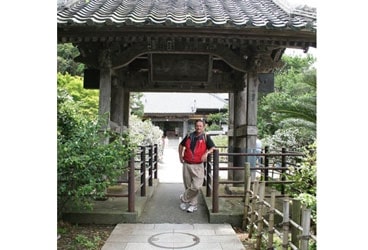
Shimoda Gate 368
One hundred and fifty-four years ago, U.S. Navy Commodore Mathew Perry sailed into Shimoda Harbor, south of what was then called Edo, now known as Tokyo. Although his mission to have the Japanese government open up its ports to American shipping was diplomatic, his seven black gun-ships were not. Under this thinly veiled threat of superior force and an obvious willingness to use it, the Japanese authorities opened up selected “Treaty Ports” and thus abruptly ended nearly 300 years of isolation.
This week Diana and I sailed into Shimoda, tied up to the pier beneath the commemorative statue of Perry, and issued a similar communique: Open your ports to American sailing ships!
Perhaps I should have painted the Roger Henry a more ominous black, for no one paid the slightest bit of attention. Then followed the ponderous procedure of Customs, Quarantine, Japan Coast Guard inspections, and petitions for permission to enter “closed” ports en route north. I will be forced to bring this matter up when I next lunch with the President.
It is ironic that the Japanese would celebrate such an aggressive intrusion as Perry’s, but Shimoda’s fame and now fortune is tied to that event. A replica of Perry’s paddle wheel ferries happy tourists around the harbor and even the manhole covers are cast with images of his ships. We watched busloads of Japanese tourists file past Perry’s statue and bow reverently as if it were a shrine. And perhaps it is of sorts, for Japan’s history pivoted around that moment. At the base of the statue burns a perpetual flame that symbolizes the enduring friendship between the United States and Japan. Next to it lies a plaque to honor Perry’s home port and Shimoda’s official sister city, Newport, Rhode Island.
In spite of our tumultuous past and ongoing issues, such as U.S. military bases in Okinawa, the Japanese love America. Until the recent economic expansion of China, they have looked more to the West than the Orient for their sense of national identity. Baseball, jazz, and jeans, they have bought into the breezy American Way.
But they are extremely sensitive to our criticisms. In a small sushi restaurant we met a Japanese woman who has spent the last 25 years teaching Japanese studies in an American university. She asked me to taste a mystery-meat and guess what it was.
I said it tasted somewhere between fatty meat and fish–strong but good.
“It’s whale meat!” she yelled. She pointed her finger at me. “You liked it!” she said in a tone that meant there was no going back for me now.
I wondered if she would force me to wash it down with hummingbird tongue soup.
“It’s part of our culture,” she protested. “What is it with you Americans and whales? They’re just big fish.”
Yes, just big fish, scientifically no more important than any one of a thousand species. But, like the panda or cheetah, they have captured the imagination of the world and thus helped pose the question: When is enough enough? Will we topple the last redwood, carve up the last ivory tusk for souvenirs, and harpoon the last sea behemoth as “part of our cultures”? Or will we transform those cultures and take some of the pressure off this weary world?
Another “never at this time of year” typhoon threatened the mid-coast of Japan. While waiting for it to either pounce or clear off, Diana and I wandered down the quaint narrow streets of Shimoda. The town offers beautiful temples, numerous parks, a scenic gondola car, and from June through July, an explosion of hydrangeas. Just as they do for the cherry blossoms in April, people fly in from all over the nation to participate in the Shimoda Hydrangea Festival. Once under control, the Japanese adore nature like no other people I have met.
The signature architecture of old Shimoda is square stone construction with white Xs embossed on each black brick. One beautiful old building, now a restaurant, was once the center of a flourishing black market between the foreign sailors and Japanese merchants. After the limited Treaty Ports were established, all trade with the white devils in Shimoda was absolutely forbidden. But the government officials who were supposed to prevent such commerce turned a blind eye for a healthy 30 percent rake on all transactions. It is truly one world.
We would have loved to linger in Shimoda, but decided the town anchorage was not secure enough to handle that typhoon now inexplicably rolling north instead of taking the usual track to the west. We decided to slip the lines for an overnight sail to the bulletproof Aburatsubo Bay in Sagami Wan.
On several occasions I have hove to at night off the entrance to the Panama Canal dodging what I thought was a dangerous amount of shipping traffic. I had no idea. This night, I would have found the bay, sparkling all green and red, quite beautiful but I was otherwise engaged in avoiding being crushed.
For more photos Click Here








